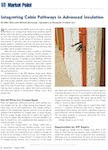As mentioned in an earlier post, we view this investigation as a unique way to bring science out of the classroom and into the real world. A way to engage the creative minds of our kids in a practical exercise that reinforces what they are learning in school while we answer a question that our customers have.
Whoa! Did You Say Hollow?
”If that thing is in my wall displacing some insulation, what affect does it have on energy conservation?”
The short answer is that the eXapath in-wall cable pathway system does not present a problem with energy conservation...but it’s a complex question that deserves thorough investigation and a complete response. Getting to that answer is, well, a science project in heat transfer, an adventure into the second law of thermodynamics.
Our Investigation
We assembled the gang, discussed the main question, and then probed more deeply, encouraging the kids to think of approaches to investigating the affect of the eXapath system on energy conservation.
The kids learned about home design and construction. We discussed framing, sheathing and all the stuff hidden in walls. Namely - insulation, drywall, vapor barriers, siding, wiring, pipes, vents, etc. We then discussed various heating systems and how insulation helps slow down the process of heat transfer from warm to cold...inside to outside during the cold winter months. To make it official I uttered “the second law of thermodynamics” one time only, noticed the kids eyes rolling, and reverted to energy conservation and the importance of efficiency in homes.
Much of the discussion revolved around insulation and how it takes advantage of the thermal properties of air to slow down heat transfer. We showed the kids several types of insulation including fiberglass batting, cellulose, and a relatively new form called sprayfoam. For our project we selected sprayfoam for its unique ability, when applied, to find its way into all cracks and voids that might otherwise allow air infiltration. The foam cures in minutes while trapping air and offers high R value (resistance to heat transfer). For this experiment we needed to emulate insulation in a full scale home so we contacted local insulation experts for advice.
Air that is moving or circulating is ineffective as insulation but “trapped”, “still”, or “dead” air offers good insulation. A key goal in construction and weatherization is to minimize air exchange or infiltration. With eXapath, the preferred installation includes firestopping caulk where the system penetrates the shoe or plate of a wall. In addition, the exposed eXapath pipe is blocked with a cap or pliable firestopping putty. An unintended benefit of firestopping is the creation of a closed system containing still air...a good insulator.
How Good is Good?
To answer the question of how the eXapath system affects an insulated wall we needed a way to control some variables and isolate the effect of the eXapath system. We turned to the kids for their ideas and were enlightened by their grasp of the complex variables involved...they truly see no limits.
The kids envisioned building an estate tricked-out with geothermal HVAC, solar photovoltaic electricity, wind power, abnormally thick walls to hold more insulation, a heated pool, horses, lots of horses...and a piranha infested moat.
I did my best to explain that their ideas were terrific but slightly beyond the scope of our plan and budget. After negotiating a bit we settled for an insulated 5 foot cube with 2 x 6” walls, floor and cover. For a heat source we opted out of geothermal and chose a top-of-the-line 100 Watt incandescent light bulb powered by mundane but readily available AC electricity. The idea is to create a strong thermal gradient between the warm internal temperature and the cooler outside air. We anticipated that the “system” would constantly fight to reach equilibrium as outside temperatures fluctuated and that by checking the temperature along the wall precisely where the eXapath was installed we would learn more about the affect of eXapath on energy conservation. In addition, using traditional framing, we could collect additional data from a wall section backed by only insulation and where a 2 x 6” stud met the sheathing. Doing so should allow us to compare traditional construction methods with those using the modern eXapath system.
Building the Chamber
All walls, floor and cover are modular and built by Bogaert Construction using 2x6” framing materials with 1/2” CDX sheathing. Local experts from USInsulation filled the modular wall cavities with 5 1/2 inches of Demilec Sealection Agrilbalance®, a 3/4 pound semi-rigid sprayfoam.
The six components (walls, floor, cover) were then assembled by the Homepath Products team, kids included.
We added the light bulb and installed an internal temperature sensor. After giving the system a dry-run to test the heat source and internal temperature sensor we sealed all internal joints with Great Stuff™. To minimize convection we added HILTI CP-618 firestopping putty to plug the exposed pipe of the eXapath system and then sealed all external seams with silicone caulking.
What We Expect to Find
For data collection and to allow meaningful comparison we plan to use a number of temperature sensors. One is housed inside the chamber to keep tabs on the internal temp and to verify that the heat source is still functioning. We also plan to monitor the outside air temperature. Ideally, the skin of the chamber should equal that of the outside air temperature, indicating that the insulation is 100% effective in conserving energy. The second law of thermodynamics tells us that heat transfer can never be stopped, only slowed down.
Therefore we expect readings from the skin of the chamber to be slightly higher than the outside air temperature. This will confirm that some heat is escaping through the materials within the walls. For external readings we plan to use an Infrared (IR) thermometer to monitor target markings for the wall section where eXapath, insulation only, and a 2 x 6” stud are located. The chamber itself is oriented so that the target wall faces north away from direct exposure to sunlight...this minimizes solar radiation as a variable in raising the skin temperature.
After the initial shakedown we moved the chamber outside into the cold New England elements and allowed it to stabilize for forty-eight hours. Once stablized we began logging temperature readings.
The testing is underway, please check part 3 of this series for interim results.















.jpg)


No comments:
Post a Comment